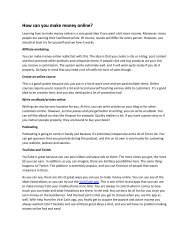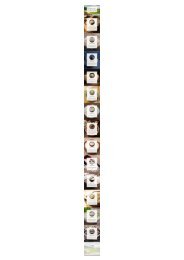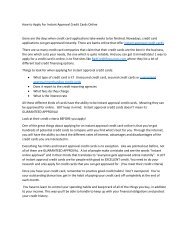How to convert photos to canvas
https://www.londoncanvasprints.com/ How to create a Scandi look with canvas prints
https://www.londoncanvasprints.com/
How to create a Scandi look with canvas prints
Create successful ePaper yourself
Turn your PDF publications into a flip-book with our unique Google optimized e-Paper software.
<strong>How</strong> To Create Canvas Prints<br />
The humorous side (and dangers) of pho<strong>to</strong>graphy addiction<br />
When you think which pho<strong>to</strong>s should you <strong>convert</strong> <strong>to</strong> <strong>canvas</strong> and decorate your home, it’s<br />
good <strong>to</strong> browse some good examples available here. There used <strong>to</strong> be a time (not so many<br />
moons ago!) where taking pictures was a luxury afforded <strong>to</strong> few.<br />
Cameras required you <strong>to</strong> put a film in<strong>to</strong> the device, with around 30 pho<strong>to</strong>s per roll. You then<br />
had <strong>to</strong> demand your family all posed perfectly, because you only had one shot. Every moment<br />
was captured thoughtfully and carefully <strong>to</strong> make the best use of the film.<br />
You're probably thinking back now <strong>to</strong> your own memories of these (shall we say 'his<strong>to</strong>ric'?)<br />
devices. I mean, they're almost worthy of museum space (although film is very much coming<br />
back in 'vogue').<br />
Once the day was over, you still didn't know what you'd caught.<br />
The anticipation was rife, but you had <strong>to</strong> visit the pho<strong>to</strong>graphy shop <strong>to</strong> get the pho<strong>to</strong>s printed.<br />
This <strong>to</strong>ok several days. Only then, once you'd collected them, would you know if everyone<br />
had been smiling, or if the flash worked, or if you had managed <strong>to</strong> superimpose a ghost, or a<br />
thumb, in<strong>to</strong> a picture. Although it was easy <strong>to</strong> be enthralled by how it all worked, it was pretty<br />
hard <strong>to</strong> be an addict.<br />
Those who always had a disposable camera in hand at family parties may have felt like they<br />
were a huge pho<strong>to</strong>graphy lover, but it was pretty impossible for them <strong>to</strong> get the same 'hit' that<br />
we now all recognise. They didn't have the ability <strong>to</strong> focus their lens in the way we can now,<br />
or review their images as it happened. They couldn't quickly edit their images after the event,<br />
or click their shutter multiple times in a matter of seconds <strong>to</strong> get the exact movement desired.
Truthfully, pho<strong>to</strong>graphy addiction is a side-effect of the rise of 'digital' - a space in which<br />
being obsessive compulsive is absolutely okay.
Nowadays, you can literally capture anything and everything at the tap of a finger.<br />
Not only thanks <strong>to</strong> how advanced camera equipment is, but also due <strong>to</strong> how developed<br />
mobile phones have become, there really isn't a single thing off limits when it comes <strong>to</strong><br />
capturing them. What you had for dinner, every corner of your holiday (sometimes in 360-<br />
degree views), what outfit you're wearing that day, every outtake <strong>to</strong>o... and it's not just<br />
capturing the moment (which can be down <strong>to</strong> the very second thanks <strong>to</strong> pho<strong>to</strong> bursts). You<br />
can now edit them, often very quickly, <strong>to</strong> completely change the pho<strong>to</strong>. From the colours, <strong>to</strong><br />
who is in it, <strong>to</strong> where the person or image was taken, <strong>to</strong> how they look, <strong>to</strong> any mistakes or<br />
inconsistencies - everything can be revised.<br />
It starts <strong>to</strong> become addictive. You find you want <strong>to</strong> do more with what you're capturing...<br />
that you actually feel like you're quite good at it. The cost of getting your hands on an entrylevel<br />
DSLR has come down (or maybe you're a Canon EOS 5DS lover - or a Nikon D750<br />
fan?). A tripod (or selfie stick) is easy <strong>to</strong> buy online, and with a few quick YouTube videos,<br />
you're a professional - right?<br />
Suddenly you're finding yourself increasingly hooked. You want <strong>to</strong> get the next mid-level<br />
camera, and then a full-frame camera. You've got the EOS-1D X hanging off your right<br />
shoulder at all times. You need (it's definitely a 'need' rather than a 'want') the various lenses,<br />
plus umbrellas and soft boxes, multiple flashes and batteries. In fact, you need more than one<br />
of each - and there's always going <strong>to</strong> be a need <strong>to</strong> keep switching these when you find 'better'<br />
versions. You're talking <strong>to</strong> your family about resolution sizes and viewfinders, how many<br />
millions of dots make up your moni<strong>to</strong>r, and what level your AF system and au<strong>to</strong>-focus<br />
arrangement is. You're talking about frames per second of shooting, the maximum continuous<br />
shooting speed, and what your sensor size is. The acronym APS-C CMOS doesn't make you<br />
think of outer space.<br />
Of course, then you also need <strong>to</strong> update your computer so it can handle all the images you're<br />
uploading and editing. You also need a website <strong>to</strong> showcase your work on. There's multiple<br />
subscriptions you can buy and blogs you can sign up for, with a whole crowd of like-minded<br />
individuals ready for you <strong>to</strong> chat with in these forums.<br />
It's definitely okay <strong>to</strong> be thinking about pho<strong>to</strong>graphy 24/7. You don't feel bad that you need <strong>to</strong><br />
keep changing and upgrading your equipment; that you're first in line for the latest releases or<br />
sweating because you can't get your hands on the best launches as quickly as you'd like. That<br />
every event you go <strong>to</strong> is like a professional pho<strong>to</strong> shoot.<br />
Are you reading this and thinking it all sounds familiar? It's okay - these experiences are<br />
common. In fact, consider this an instance in which you are googling your symp<strong>to</strong>ms and<br />
have stumbled across a particularly reliable and well-supported medical page. You, my friend,<br />
are a pho<strong>to</strong>graphy addict.<br />
Here's what you're probably experiencing...<br />
- Breathlessness (at new camera launches)
- Palpitations (when you can't get your hands on a new release)<br />
- Exhaustion (at spending multiple hours editing images <strong>to</strong> be 'perfect')<br />
- Inability <strong>to</strong> drink or eat (because you're constantly holding your camera at events)<br />
- Memory issues (no, scrap that, everything is recorded on camera... you can relay your day<br />
minute-by-minute)<br />
- Finger spasms (from having it on the camera but<strong>to</strong>ns at all hours)<br />
- Hallucinations (did you really visit Barbados or was that palm tree pho<strong>to</strong>-shopped in?)<br />
The good news is that these symp<strong>to</strong>ms can all be easily relieved. By putting your camera<br />
down, not taking it with you <strong>to</strong> every event, and accepting that not every moment needs <strong>to</strong> be<br />
recorded, you can start <strong>to</strong> recover.<br />
Although this is easier <strong>to</strong> do with larger equipment (someone will definitely notice you trying<br />
<strong>to</strong> tuck your Sony Alpha A7R II under your coat!), it isn't so easy <strong>to</strong> rid yourself of your<br />
mobile phone - the most constant and easily accessible camera in your life. Consider getting a<br />
Polaroid camera, with which you can only take 10 film shots (the films are hugely expensive).<br />
It could completely change how you think about your phone.<br />
While it is still easy <strong>to</strong> snap away at every moment, it reminds us of how cameras used <strong>to</strong> be -<br />
the way it was at the start of this s<strong>to</strong>ry. Of how you had <strong>to</strong> pick and choose your moments<br />
carefully and be selective. There was no editing, no reviewing the picture and asking <strong>to</strong> do it<br />
over and over until you got it right, and no deleting.<br />
It was much easier <strong>to</strong> just live in the moment and accept life for how it was as it was<br />
happening. If you got a good picture, it was great. But the pressure wasn't so pronounced. It<br />
didn't dictate the shape of your day. You could enjoy yourself, and the camera was secondary<br />
<strong>to</strong> this fun.<br />
In curing your addiction, sometimes we need <strong>to</strong> think this way. It's about imagining you only<br />
have that limited film in your camera (or your phone). What would you capture in a day if you<br />
could only take 10 shots? Or 30, as a maximum? Or if editing wasn't an option? Would that<br />
moment be worth wasting film on, if there was a limit <strong>to</strong> what you were doing? Ultimately,<br />
it's this perspective that will help you overcome the dangers of your addiction.<br />
Good luck!

















